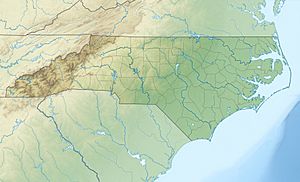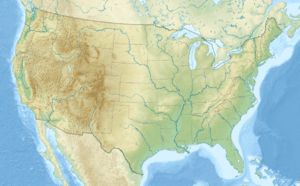Roaring Fork (Fisher River tributary) facts for kids
Quick facts for kids Roaring Fork |
|
|---|---|
|
Location of Roaring Fork mouth
|
|
| Other name(s) | Tributary to Fisher River |
| Country | United States |
| State | North Carolina |
| County | Surry Alleghany |
| Physical characteristics | |
| Main source | Ramey Creek divide about 2 miles south-southwest of High Point Spur 2,730 ft (830 m) 36°31′17″N 080°55′32″W / 36.52139°N 80.92556°W |
| River mouth | Fisher River about 1 mile south of Lowgap, North Carolina 1,258 ft (383 m) 36°30′17″N 080°51′20″W / 36.50472°N 80.85556°W |
| Length | 5.84 mi (9.40 km) |
| Basin features | |
| Progression | generally southeast |
| River system | Yadkin River |
| Basin size | 13.09 square miles (33.9 km2) |
| Tributaries |
|
| Bridges | Fishers Peak View, Carson Creek Road (x2), Ramey Creek Road (x2), Warrior Mountain Lane |
Roaring Fork is a cool river in North Carolina, about 5.84 mi (9.40 km) long. It's like a smaller stream that flows into a bigger river. Roaring Fork is a "tributary" to the Fisher River. This means it's one of the many streams that feed water into the Fisher River. You can find it in Surry County, North Carolina.
Where Does Roaring Fork Flow?
Roaring Fork starts high up in the mountains, near a place called High Point Spur. It begins where the land divides the water flow for Ramey Creek. From there, the river flows mostly towards the southeast. It keeps going until it joins the Fisher River. This meeting point is about 1 mile south of a town called Lowgap, North Carolina.
What is Roaring Fork's Watershed?
A "watershed" is like a giant bowl or area of land. All the rain and snow that falls in this area eventually drains into one main river or stream. Roaring Fork's watershed covers about 13.09 square miles (33.9 km2) of land. A lot of this area, about 74%, is covered in forests. This means there are many trees and plants that help keep the water clean.



